2003 CHEVROLET IMPALA weight
[x] Cancel search: weightPage 251 of 408
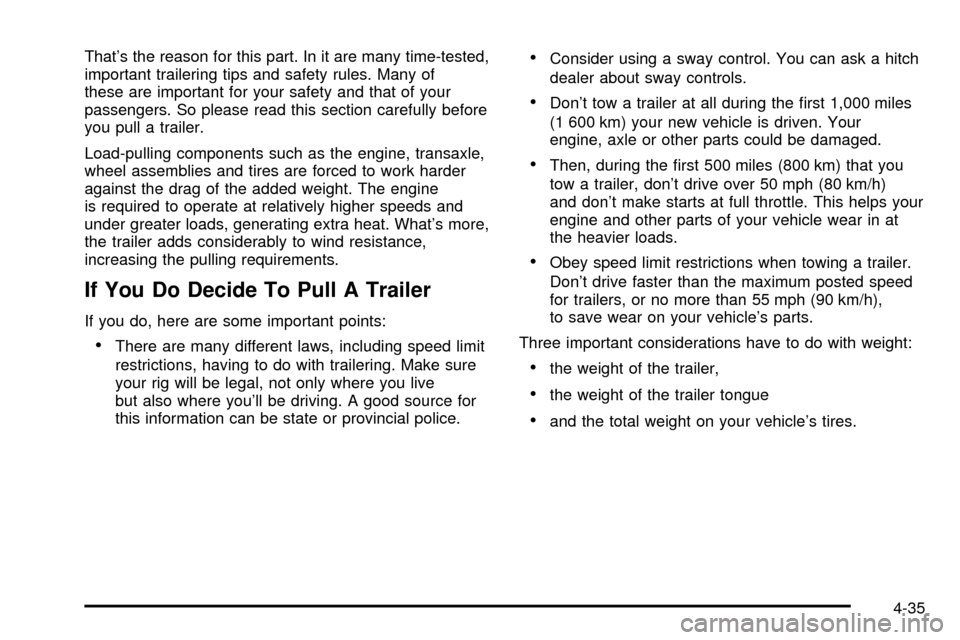
That's the reason for this part. In it are many time-tested,
important trailering tips and safety rules. Many of
these are important for your safety and that of your
passengers. So please read this section carefully before
you pull a trailer.
Load-pulling components such as the engine, transaxle,
wheel assemblies and tires are forced to work harder
against the drag of the added weight. The engine
is required to operate at relatively higher speeds and
under greater loads, generating extra heat. What's more,
the trailer adds considerably to wind resistance,
increasing the pulling requirements.
If You Do Decide To Pull A Trailer
If you do, here are some important points:
·There are many different laws, including speed limit
restrictions, having to do with trailering. Make sure
your rig will be legal, not only where you live
but also where you'll be driving. A good source for
this information can be state or provincial police.
·Consider using a sway control. You can ask a hitch
dealer about sway controls.
·Don't tow a trailer at all during the ®rst 1,000 miles
(1 600 km) your new vehicle is driven. Your
engine, axle or other parts could be damaged.
·Then, during the ®rst 500 miles (800 km) that you
tow a trailer, don't drive over 50 mph (80 km/h)
and don't make starts at full throttle. This helps your
engine and other parts of your vehicle wear in at
the heavier loads.
·Obey speed limit restrictions when towing a trailer.
Don't drive faster than the maximum posted speed
for trailers, or no more than 55 mph (90 km/h),
to save wear on your vehicle's parts.
Three important considerations have to do with weight:
·the weight of the trailer,
·the weight of the trailer tongue
·and the total weight on your vehicle's tires.
4-35
Page 252 of 408
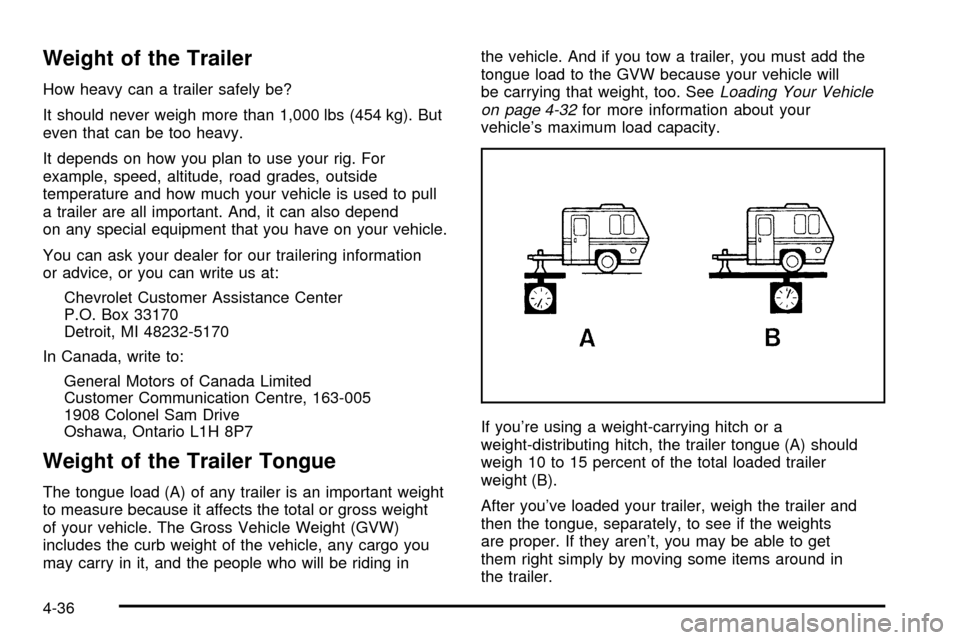
Weight of the Trailer
How heavy can a trailer safely be?
It should never weigh more than 1,000 lbs (454 kg). But
even that can be too heavy.
It depends on how you plan to use your rig. For
example, speed, altitude, road grades, outside
temperature and how much your vehicle is used to pull
a trailer are all important. And, it can also depend
on any special equipment that you have on your vehicle.
You can ask your dealer for our trailering information
or advice, or you can write us at:
Chevrolet Customer Assistance Center
P.O. Box 33170
Detroit, MI 48232-5170
In Canada, write to:
General Motors of Canada Limited
Customer Communication Centre, 163-005
1908 Colonel Sam Drive
Oshawa, Ontario L1H 8P7
Weight of the Trailer Tongue
The tongue load (A) of any trailer is an important weight
to measure because it affects the total or gross weight
of your vehicle. The Gross Vehicle Weight (GVW)
includes the curb weight of the vehicle, any cargo you
may carry in it, and the people who will be riding inthe vehicle. And if you tow a trailer, you must add the
tongue load to the GVW because your vehicle will
be carrying that weight, too. See
Loading Your Vehicle
on page 4-32for more information about your
vehicle's maximum load capacity.
If you're using a weight-carrying hitch or a
weight-distributing hitch, the trailer tongue (A) should
weigh 10 to 15 percent of the total loaded trailer
weight (B).
After you've loaded your trailer, weigh the trailer and
then the tongue, separately, to see if the weights
are proper. If they aren't, you may be able to get
them right simply by moving some items around in
the trailer.
4-36
Page 253 of 408
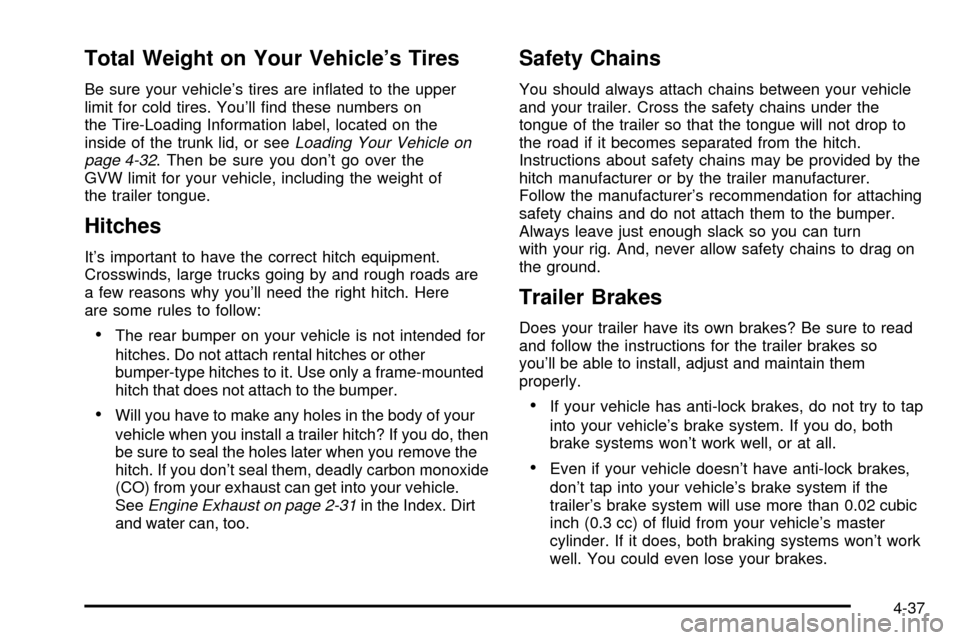
Total Weight on Your Vehicle's Tires
Be sure your vehicle's tires are in¯ated to the upper
limit for cold tires. You'll ®nd these numbers on
the Tire-Loading Information label, located on the
inside of the trunk lid, or see
Loading Your Vehicle on
page 4-32. Then be sure you don't go over the
GVW limit for your vehicle, including the weight of
the trailer tongue.
Hitches
It's important to have the correct hitch equipment.
Crosswinds, large trucks going by and rough roads are
a few reasons why you'll need the right hitch. Here
are some rules to follow:
·The rear bumper on your vehicle is not intended for
hitches. Do not attach rental hitches or other
bumper-type hitches to it. Use only a frame-mounted
hitch that does not attach to the bumper.
·Will you have to make any holes in the body of your
vehicle when you install a trailer hitch? If you do, then
be sure to seal the holes later when you remove the
hitch. If you don't seal them, deadly carbon monoxide
(CO) from your exhaust can get into your vehicle.
See
Engine Exhaust on page 2-31in the Index. Dirt
and water can, too.
Safety Chains
You should always attach chains between your vehicle
and your trailer. Cross the safety chains under the
tongue of the trailer so that the tongue will not drop to
the road if it becomes separated from the hitch.
Instructions about safety chains may be provided by the
hitch manufacturer or by the trailer manufacturer.
Follow the manufacturer's recommendation for attaching
safety chains and do not attach them to the bumper.
Always leave just enough slack so you can turn
with your rig. And, never allow safety chains to drag on
the ground.
Trailer Brakes
Does your trailer have its own brakes? Be sure to read
and follow the instructions for the trailer brakes so
you'll be able to install, adjust and maintain them
properly.
·If your vehicle has anti-lock brakes, do not try to tap
into your vehicle's brake system. If you do, both
brake systems won't work well, or at all.
·Even if your vehicle doesn't have anti-lock brakes,
don't tap into your vehicle's brake system if the
trailer's brake system will use more than 0.02 cubic
inch (0.3 cc) of ¯uid from your vehicle's master
cylinder. If it does, both braking systems won't work
well. You could even lose your brakes.
4-37
Page 254 of 408
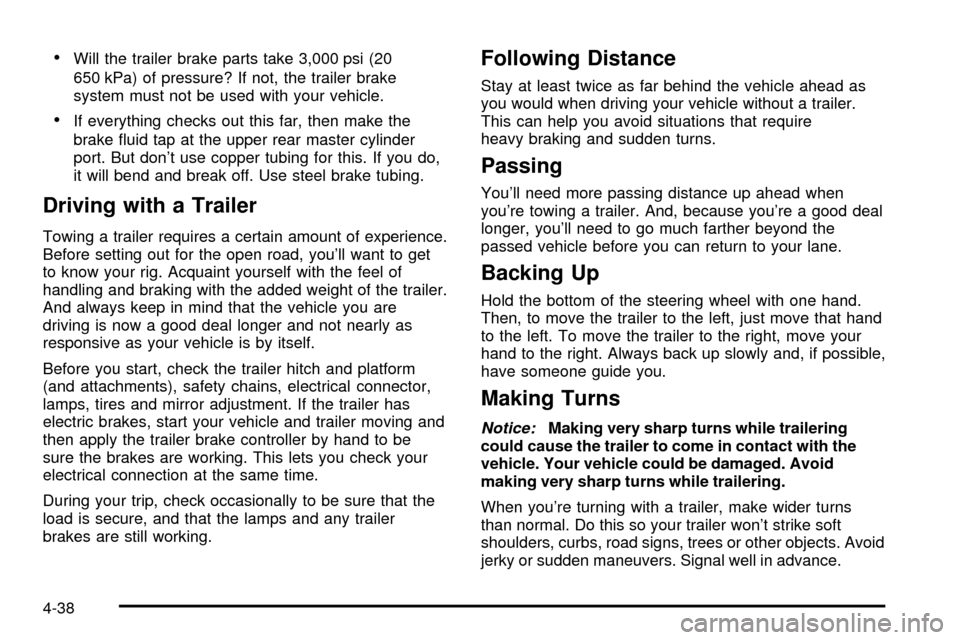
·Will the trailer brake parts take 3,000 psi (20
650 kPa) of pressure? If not, the trailer brake
system must not be used with your vehicle.
·If everything checks out this far, then make the
brake ¯uid tap at the upper rear master cylinder
port. But don't use copper tubing for this. If you do,
it will bend and break off. Use steel brake tubing.
Driving with a Trailer
Towing a trailer requires a certain amount of experience.
Before setting out for the open road, you'll want to get
to know your rig. Acquaint yourself with the feel of
handling and braking with the added weight of the trailer.
And always keep in mind that the vehicle you are
driving is now a good deal longer and not nearly as
responsive as your vehicle is by itself.
Before you start, check the trailer hitch and platform
(and attachments), safety chains, electrical connector,
lamps, tires and mirror adjustment. If the trailer has
electric brakes, start your vehicle and trailer moving and
then apply the trailer brake controller by hand to be
sure the brakes are working. This lets you check your
electrical connection at the same time.
During your trip, check occasionally to be sure that the
load is secure, and that the lamps and any trailer
brakes are still working.
Following Distance
Stay at least twice as far behind the vehicle ahead as
you would when driving your vehicle without a trailer.
This can help you avoid situations that require
heavy braking and sudden turns.
Passing
You'll need more passing distance up ahead when
you're towing a trailer. And, because you're a good deal
longer, you'll need to go much farther beyond the
passed vehicle before you can return to your lane.
Backing Up
Hold the bottom of the steering wheel with one hand.
Then, to move the trailer to the left, just move that hand
to the left. To move the trailer to the right, move your
hand to the right. Always back up slowly and, if possible,
have someone guide you.
Making Turns
Notice:Making very sharp turns while trailering
could cause the trailer to come in contact with the
vehicle. Your vehicle could be damaged. Avoid
making very sharp turns while trailering.
When you're turning with a trailer, make wider turns
than normal. Do this so your trailer won't strike soft
shoulders, curbs, road signs, trees or other objects. Avoid
jerky or sudden maneuvers. Signal well in advance.
4-38
Page 406 of 408
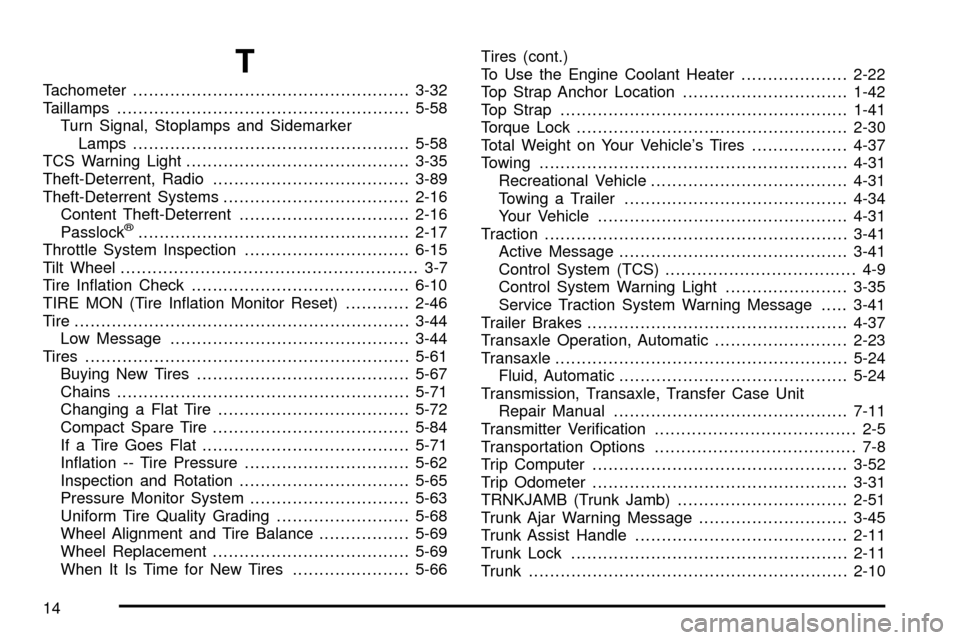
T
Tachometer....................................................3-32
Taillamps.......................................................5-58
Turn Signal, Stoplamps and Sidemarker
Lamps....................................................5-58
TCS Warning Light..........................................3-35
Theft-Deterrent, Radio.....................................3-89
Theft-Deterrent Systems...................................2-16
Content Theft-Deterrent................................2-16
Passlock
ž...................................................2-17
Throttle System Inspection...............................6-15
Tilt Wheel........................................................ 3-7
Tire In¯ation Check.........................................6-10
TIRE MON (Tire In¯ation Monitor Reset)............2-46
Tire ...............................................................3-44
Low Message.............................................3-44
Tires.............................................................5-61
Buying New Tires........................................5-67
Chains.......................................................5-71
Changing a Flat Tire....................................5-72
Compact Spare Tire.....................................5-84
If a Tire Goes Flat.......................................5-71
In¯ation -- Tire Pressure...............................5-62
Inspection and Rotation................................5-65
Pressure Monitor System..............................5-63
Uniform Tire Quality Grading.........................5-68
Wheel Alignment and Tire Balance.................5-69
Wheel Replacement.....................................5-69
When It Is Time for New Tires......................5-66Tires (cont.)
To Use the Engine Coolant Heater....................2-22
Top Strap Anchor Location...............................1-42
Top Strap......................................................1-41
Torque Lock...................................................2-30
Total Weight on Your Vehicle's Tires..................4-37
Towing..........................................................4-31
Recreational Vehicle.....................................4-31
Towing a Trailer..........................................4-34
Your Vehicle...............................................4-31
Traction.........................................................3-41
Active Message...........................................3-41
Control System (TCS).................................... 4-9
Control System Warning Light.......................3-35
Service Traction System Warning Message.....3-41
Trailer Brakes.................................................4-37
Transaxle Operation, Automatic.........................2-23
Transaxle.......................................................5-24
Fluid, Automatic...........................................5-24
Transmission, Transaxle, Transfer Case Unit
Repair Manual............................................7-11
Transmitter Veri®cation...................................... 2-5
Transportation Options...................................... 7-8
Trip Computer................................................3-52
Trip Odometer................................................3-31
TRNKJAMB (Trunk Jamb)................................2-51
Trunk Ajar Warning Message............................3-45
Trunk Assist Handle........................................2-11
Trunk Lock....................................................2-11
Trunk............................................................2-10
14
Page 407 of 408
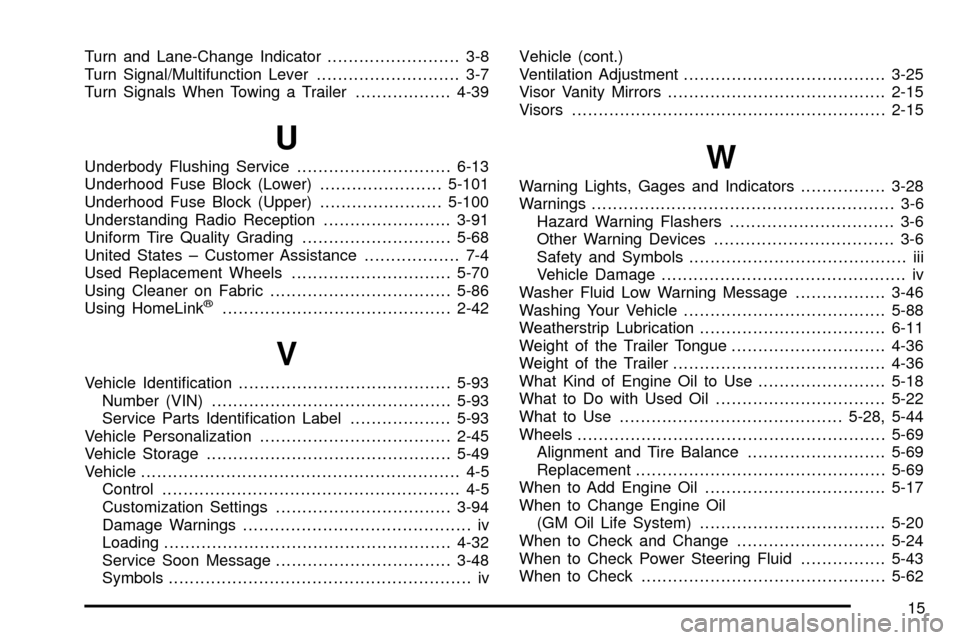
Turn and Lane-Change Indicator......................... 3-8
Turn Signal/Multifunction Lever........................... 3-7
Turn Signals When Towing a Trailer..................4-39
U
Underbody Flushing Service.............................6-13
Underhood Fuse Block (Lower).......................5-101
Underhood Fuse Block (Upper).......................5-100
Understanding Radio Reception........................3-91
Uniform Tire Quality Grading............................5-68
United States ± Customer Assistance.................. 7-4
Used Replacement Wheels..............................5-70
Using Cleaner on Fabric..................................5-86
Using HomeLink
ž...........................................2-42
V
Vehicle Identi®cation........................................5-93
Number (VIN).............................................5-93
Service Parts Identi®cation Label...................5-93
Vehicle Personalization....................................2-45
Vehicle Storage..............................................5-49
Vehicle............................................................ 4-5
Control........................................................ 4-5
Customization Settings.................................3-94
Damage Warnings........................................... iv
Loading......................................................4-32
Service Soon Message.................................3-48
Symbols......................................................... ivVehicle (cont.)
Ventilation Adjustment......................................3-25
Visor Vanity Mirrors.........................................2-15
Visors...........................................................2-15
W
Warning Lights, Gages and Indicators................3-28
Warnings......................................................... 3-6
Hazard Warning Flashers............................... 3-6
Other Warning Devices.................................. 3-6
Safety and Symbols......................................... iii
Vehicle Damage.............................................. iv
Washer Fluid Low Warning Message.................3-46
Washing Your Vehicle......................................5-88
Weatherstrip Lubrication...................................6-11
Weight of the Trailer Tongue.............................4-36
Weight of the Trailer........................................4-36
What Kind of Engine Oil to Use........................5-18
What to Do with Used Oil................................5-22
What to Use..........................................5-28, 5-44
Wheels..........................................................5-69
Alignment and Tire Balance..........................5-69
Replacement...............................................5-69
When to Add Engine Oil..................................5-17
When to Change Engine Oil
(GM Oil Life System)...................................5-20
When to Check and Change............................5-24
When to Check Power Steering Fluid................5-43
When to Check..............................................5-62
15